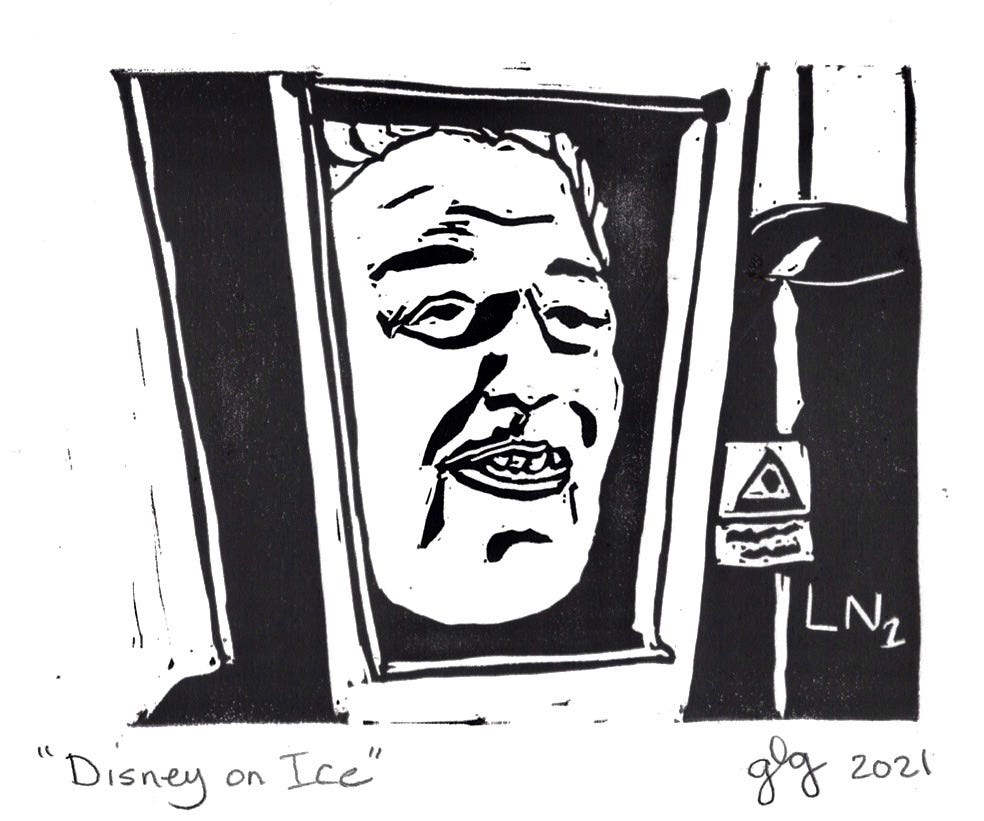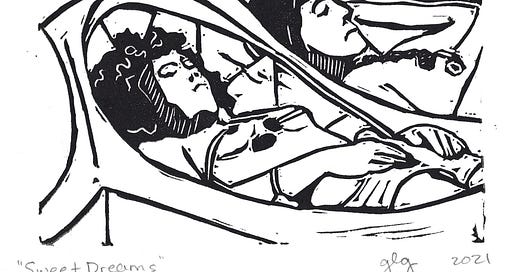Hey Baby It’s Cold Outside, Let’s Stay In and Talk About the Weather
So, as the temperature in Chicagoland is making up it’s mind between winter and summer, I’ve been watching climate disaster movie/TV shows—you know the ones where the temperature becomes unstable and life as we know it is over—The Day After Tomorrow and the TV series SnowPiercer (season 2, and the movie was good also).
The Day After Tomorrow (DAT) is the movie where climate change forces the Earth into an unexpected ice age, and a plucky group of resourceful humans hole-up in the New York Public Library as the super cold storm passes; as a dad makes a daring road trip to rescue his son and finally keep his promise to be there (yes there are a lot of scientific inaccuracies, but let’s just keep the handwavium flowing until I get to my punchline, thanks for playing along.)
Snowpiercer, equally entertaining and heavy handed with Handwavium, but again climate change cools the entire Earth’s temperature (already better science than DAT, sorry I forgot about the handwavium) and instead of hiding in a public library (because the entire world’s population couldn’t fit into one) they build a train, hundreds of cars long, that circumnavigates the world continually. Both very entertaining and worth a watch, but I’m sure you are wondering, “Jotham, what’s the point of all this?”
Okay, you got me; I just wanted to talk about DAT because it’s a fun movie with really hokey science at times (one of Yahoo’s top 10 scientifically inaccurate movies) and I wanted to say handwavium a bunch of times, because that’s like my thing now. So, to the real Rabbit Hole I went down, Cryonics and freezing body parts off (but more on that later.)

I’m Gonna Live Forever, I’m Gonna Learn How to Vitreously Freeze Myself
First things first, what is Cryonics?
Cryonics is the low-temperature vitreous freezing (usually at Liquid Nitrogen temperatures: −196 °C or −320.8 °F) and storage of a human, human corpse or severed head for later revival.
What is this Vitreous Freeze Myself Business (Changing the lyrics to Irene Cara’s Fame song like that: I’m Gonna Live Forever, I’m Gonna Learn How To Fly, Jotham!)?
Well, when you freeze something with water in it (like a human body or brain which is a lot of water), the water expands as crystals as it freezes (expansion of water when it freezes is a unique property). These ice crystals would be bad for your cells (think Superman’s fortress of solitude, but forming inside your cells, ouch).
So, to make cryonics work, you want to freeze the water in a way to avoid ice crystallization and create vitreous ice (glass like). Without going into the physics of water; Vitreous ice does not expand into crystals upon solidification, and this makes it the only desirable form of freezing for biological specimens. Especially, if you want to revive or study that specimen you froze (more on that later). Yes, I know later is really piling up with information.
So how does Cryonics work in Science Fiction (a couple general themes):
1) Space travel: Moves and books like Alien, and The Three Body Problem by Liu Cixin (Book#2 The Dark Forest), the cryogenic chamber discovered by the Fourth Doctor in the Nerva Beacon;
2) Storage (frozen today and revived sometime in the future): Fry from Futarama; Faye Valentine from Cowboy Beebop (just finished watching this series again on Hulu, cannot wait for the Live action version); Austin Powers, Demolition Man, Steve Rogers (MCU), Bucky Barnes (MCU), and Han-Solo to name a few.
And this brings me back full circle, like the Snowpiercer circumnavigating the world in a train hundreds of cars long—see what I did there—in Snowpiercer they use cryonics to store humans for a future when outdoor temps return to normal, but they also use the extreme temperatures to punish people by exposing their limbs to the extreme cold outdoor (remember it’s so cold people can not live outdoors and have to ride around a train).
So, Can You Really Freeze Your Butt Off?
In the Snowpiercer universe the temperature is -182 °F or -119 °C (I’m not going to explain why there is a difference between Celsius and Fahrenheit, you should have paid attention in school but, I’m nice and you can click the link, but I will give you a fun fact - 40 is the temperature where C and F are equal. (Want to do the math yourself; here is the formula: (Temp °F - 32) * 5/9 = Temp °C)
So, the Snowpiercer temperature is plenty cold enough to freeze an arm solid (and very uninhabitable), but how long would it take to freeze it solid enough to shatter with a sledgehammer (it’s like a handwavium second in the show)? It wasn’t clear if the temperature mentioned in the show was with or without windchill caused by the moving train factored in.
If you are ever at a pub during trivia night and for 1 million dollars they ask who developed the wind chill factor; you can answer Charles Passel and Paul Siple (Paul coined the term wind chill). They did the experiments in Antarctica (average temperature is -58 °F or -50 °C) by measuring how long it took water to freeze in baked bean tins in different wind strengths and temperatures.
And, if you win that cool million, don’t forget your friendly neighborhood Jotham!
Okay, back to freezing off limbs. Let’s just assume the temperatures are measured using sensors on the train, which is moving, and includes the wind chill factor. Based on the amount of time it takes meat to freeze in a freezer, I’d estimate it would take between 7-10 minutes of agonizing pain to freeze someone’s arm solid.
Keep Your Arms Inside The Moving Vehicle At All Times!
Moving right along, let’s dig into cryonics, the process of freezing people to one day revive them. You may think this is only found in the pages of your favorite science fiction stories, but its a real thing! You can have your whole body or just the brain cryopreserved at the ALCOR Life Extension Foundation for future revival—once the technology to revive a person becomes available.
The whole idea is to vitrify (we talked about that earlier, freezing without forming ice crystals) the body or brain at the moment of death (clinically) and cryo-preserved. It’s estimated that ~250 people have been cryopreserved and waiting for revival. More than 1,500 people have signed up for the procedure.
And if you are wondering, the first person to be frozen was Dr. James Bedford in 1967, and he is still on ice at ALCOR. Other famous names you may have heard about being on ice include, Ted Williams’—just his head, and even Walt Disney (well more on Mr. Disney later).

As great as all this sounds, one of the issues discussed briefly on Snowpiercer, it is not, currently, possible to reanimate a person after undergoing vitrification. Why you ask? The process causes damage to cells, the brain and neural networks. The cellular damage is thought to be caused by the toxicity of the cryoprotectants used for vitrification and cellular damage caused by dehydration during the vitrification process. (I personally speculate this dehydration is caused by micro-ice crystal formation.)
Hold The Horses, What Do you Mean, “I Personally Speculate?”
The Advanced Electron Microscopy Facility @UChicago
No, I’m not freezing heads or bodies in my basement like the Re-Animator, but I use cryo-preservation techniques to preserve cells and tissues to study cellular structure with Electron Microscopy (here is one of my research articles). That’s right, when I’m not writing these fun newsletters and novels, I’m at the University of Chicago doing science (here is an interview about what I do) and replacing the handwavium with actual-factual science. And once again, I do not work on cryo-preserving humans, but that did not stop a person from asking me over beers at a science conference about freezing a human head using High-Pressure Freezing Techniques. I was also asked once if I had ideas about freezing strawberries to reduce ice crystal formation (every thaw strawberries and they are all mushy, thank those ice-crystals).
Jotham imaging a brain after cryo-preservation on a Scanning Electron Microscopy
A Few More Lose Ends to Tie Up Before I Use Mushy Strawberries To Make A Smoothie
Cryonics have a lot of roots in Science Fiction and many researchers are trying to take the Fiction out of the equation, but for now, cryonics only works in books and movies with a big dose of Handwavium.
But, as I was digging into this topic I found out that Walt Disney was never cryo-preserved in a deep-freeze chamber somewhere at Disneyland— under the “Pirates of the Caribbean” attraction which is the most frequently mentioned as the site of the cryogenic chamber. Sadly, Walt Disney passed in 1966 from lung cancer complications, and was interred at Forest Lawn Memorial Park in Glendale, California.
Well there you have it, another chilly episode of Rabbit Hole of Research. Are you still thinking about that strawberry smoothie, I know I am
—You crazy kids stay chill, until next time…
Hope you enjoyed this little trip down my Rabbit Hole of Research, and will join me next time as I reveal the actual factual science in fiction and fantasy. If you missed an episode, you can find them here. Like the prints you see in my newsletter, they are done by the talented Georgia Geis and the prints will be available for purchase at atomicnumber14.com.
Did I get something wrong ... right ... wanna say hello? Let me know, I write back— Email me
If you want to chat with me on the interwebs, find me at your favorite digital hangout!



